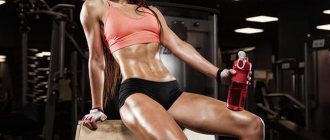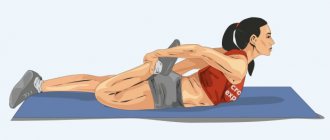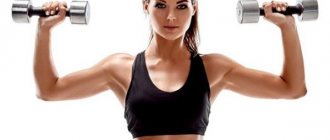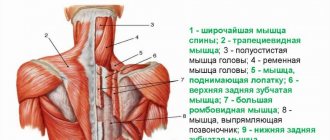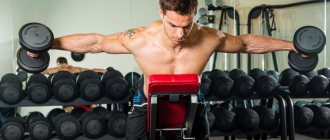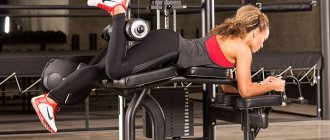How many times a week should you pump your legs? Unfortunately, not all gym goers are interested in this issue. As a rule, they are guided by the following logic: “You can’t see your legs under your pants, which means there’s no need to pump them up!” The saddest thing in this situation is that not only beginners, but also many regulars of fitness centers think this way. If you are reading these lines now, then most likely you are not one of these people, and you understand the importance of training the lower body. Well, in this case, we suggest you read our article, in which we discussed in detail how many times a week you need to pump your legs. In addition, here you will find a lot of interesting information about creating a competent training system and combining leg training with other muscle groups!
Large and small muscle groups
To give a complete and detailed answer to the question: “How many times a week should I train my legs?”, you must first understand what type of muscle group this muscle group belongs to. There are large and small muscle groups in our body. The first include the chest, back and, of course, legs (they make up approximately 50% of the total muscle mass of the human body). The second ones include biceps, triceps, deltoids and calves. It's very simple: large muscle groups require a lot of time to recover, and small muscle groups, in turn, recover several times faster. If you are a girl and want to pump up beautiful thighs, how to do this is described in this article: https://fb.ru/article/368193/kak-nakachat-bedra-devushke-byistro.
Leg exercise program
At the initial stage of the training process, beginners need to limit the arsenal of exercises, choosing only basic exercises that involve the maximum number of muscles. Only experienced athletes need to set aside a separate day for training their legs and buttocks, inclusive.
For experienced athletes, leg day looks like this:
♦ Warm-up – 5 minutes (squats with your own weight, leg stretching);
♦ Squats with a barbell – 3-4 sets of 12-8 repetitions;
♦ Lunges - 3-4 sets of 12-8 repetitions / Deadlift - 3-4 sets of 12-8 repetitions;
♦ Leg press in the simulator - 3-4 sets of 12-8 repetitions;
♦ Leg curls - 3-4 sets of 12-8 repetitions;
♦ Leg extension - 3-4 sets of 12-8 repetitions;
It is always worth remembering that in order for the leg muscles to begin to grow, it is important to perform both low and high repetitions. Reps in the 4-6 rep range increase strength, and 12-8 reps promote muscle hypertrophy.
If it is the calves that are lagging behind, then multi-repetition training of 10-15 repetitions is necessary for this muscle group. Not forgetting that in a sitting position, the soleus muscle, which is located under the gastrocnemius, is trained to a greater extent, and it is the gastrocnemius that is trained in a standing position, which provides a spectacular visual appearance.
Features of leg training
As a rule, most gym goers work out on a three-day split: chest and biceps on Monday, back and triceps on Wednesday, shoulders and legs on Friday. This scheme is familiar to many regulars of fitness centers, but it does not work for everyone. Some athletes progress without problems from training their shoulders and legs in one day, while others, on the contrary, do not see any results from such a system, without improving either here or there. In such a situation, it makes sense to set aside a separate training day for your legs, which you could devote to working them out.
Errors during pumping
At the same time as those who ignore pumping their legs, there are people who perform the exercises, but make many mistakes:
- Wrong choice of exercises. Many men and women spend too much time on isolating elements and also primarily work on machines. This approach is unacceptable. Machines and isolation exercises are an addition to the main work program, where most of the time is devoted to the base and interaction with free weights.
- Crooked squats. Execution technique is very important. But there are athletes who do not pay attention to the quality of squat training. Some of the most common mistakes are: excessive twitching, squeezing of the knees, rounding of the lower back, etc.
- Too much high repetition training. With this approach, the muscles will not only not grow, but will gradually stop developing. To get excellent results, you need to do as many multi-joint and heavy exercises as possible.
Interesting fact. The strategy for creating toned, sculpted legs is simple. First of all, we focus on heavy weights during classes (4-7 repetitions are enough). Secondly, we give preference to exercises that provide safe but progressive overload.
What happens if you train your lower body very often?
How often to pump your legs? We've already dealt with this. Now we would like to explain why you should NOT pump your legs too often. Many novice athletes mistakenly believe that if they regularly work out a certain muscle group, it will grow faster. In fact, this is far from the case. As we wrote earlier, any muscle group needs time to recover. If you train your body too often, it will not only not add muscle to you, but, on the contrary, it will ruin existing results and bring the athlete to a state where he cannot work with his usual working weights. In bodybuilding, this phenomenon is called overtraining.
Why you need to train your legs
Ideally, a person should train all muscle groups, but in practice, more attention is paid to such parts of the body as the arms and abdominal areas (abs, waist), but they somehow forget about the legs. After all, they can always be hidden under clothes, trousers, jeans, shorts. Now many people prefer to pump up their chest, back, stomach and arms, excluding leg exercises from their workouts altogether or minimizing them. Yes, and we walk every day, which means we put a sufficient load on our legs, but given the fact that most of us own personal transport and move around the city by car, our legs don’t get much exercise.
Let's figure out whether it is necessary to train legs at all and how best to do it
First of all, the main argument in favor of leg training is the fact that legs are the basis of human endurance, because, simply put, the whole body rests on them.
Secondly, since the legs contain the largest muscles of the human body, leg training has a beneficial effect on the general condition of a person.
Thirdly, training the leg muscles has a positive effect on the functioning of the heart muscle, therefore, blood supply is improved, the blood is regularly saturated with oxygen cells, which helps reduce the risk of developing diseases of the cardiovascular system and, as a result, leg training prolongs life.
Fourthly, if the upper core muscles are trained, but no time is devoted to training the legs, then the result of such training will not be harmonious. After all, an inflated top and the absence of hints of leg muscles does not look beautiful, to say the least.
Fifthly, if you spend your whole life swinging different muscle groups, ignoring and not paying due attention to your legs, then in old age it will be quite difficult to move. If in youth this problem, as a rule, does not get in the way and does not bother you much, then at the age of 50, many people notice that it becomes more and more difficult to move.
There are no arguments against training your legs; to one degree or another, training your leg muscles is useful and even necessary.
There are a lot of possibilities and methods for training your legs, the simplest of them is, of course, walking, more than 4 km a day. The next training method flows smoothly from walking – running. Running more than 3-4 km a day in a month you will notice how your leg muscles have strengthened. These are the simplest methods. More complex ones are performing various exercises on the leg muscles, in the gym or at home.
The simplest but most effective exercise is squats; they can be performed with or without additional weight. Dancing, skiing, skating and cycling also contribute to the development of leg muscles.
The truth that professional bodybuilders won't tell you
Someone, having read the section above, may object: “But Arnold Schwarzenegger and other professional bodybuilders trained almost every day! And they didn’t have any overtraining, they had wonderful results!” There is indeed some truth in these words, but one important thing is not taken into account here: absolutely all famous bodybuilders use steroids in their training. Anabolic drugs not only build muscle mass, but also significantly speed up recovery after heavy training sessions. For ordinary people who exercise without the use of pharmacological products, such training is absolutely not suitable.
Additionally, it is important to understand that even professionals like Arnold Schwarzenegger only trained in this style in the weeks leading up to competition when they needed to reach their peak condition.
Tips and tricks
From the question: “How many times a week should I pump my legs?” let's move smoothly to the question: “How to pump up your legs?” We'd like to give you some helpful tips to help you make your lower body workouts not only safe, but also effective!
1. Always warm up. Knee joints are a very vulnerable place that can be easily damaged during leg training. To prevent this from happening, before you start lifting weights, you need to do a high-quality and complete warm-up. This way you will warm up your joints and tendons and prepare them for subsequent loads. To start, work on a treadmill, exercise bike or elliptical for 5-10 minutes. After this, the next 10 minutes should be spent stretching. Remember that you need to stretch not only your quadriceps, but also all the muscles in your legs and lower back. Before your first working approach to an exercise, do 2-3 warm-up sets with light weights. It is important to understand that you need to warm up not only on leg day, but also before training any other muscle group.
2. Get enough sleep. Every person interested in how many times a week to pump their legs should know that sleep plays an important role in the body's recovery processes. To ensure your muscles have time to recover for the next training session, you must get the required amount of sleep.
3. Eat right. Your leg muscles (like any other muscle in your body) won't grow if you don't eat right. To burn fat or gain weight, you first have to change your diet. You can know the technique of performing each exercise by heart and follow all the rules of iron sports, but if your diet consists of fast food products, buns and sandwiches, then you can forget about a beautiful and aesthetic physique.
4. Perform each exercise correctly. Not only your final result, but also the integrity of your joints and tendons depends on how technically you perform each exercise. If you doubt whether you are performing the exercise correctly or not, then ask the trainer to follow you and help if something happens.
Shake your legs!
Many bodybuilders find it much more difficult to pump up their legs than any other part of the body. However, this is not surprising. After all, most of you probably start your workout with bench presses or biceps curls.
Of course, it’s the chest and biceps that catch your eye first! But the leg muscles are not so “ostentatious”, and it is very difficult to train them. So it turns out that their turn comes when you are already pretty tired. Personally, pumping up my legs wasn’t easy for me either.
And not only because I didn’t do them in the first year. The thing is that my legs are long, and the muscles on them are also long. For Lee Priest, for example, it’s easier to “give” himself powerful legs because, you know, he has them shorter.
It is important!
For us long-legged people, in order to gain the same “mass,” we need to struggle long and hard under the barbell. But in the end, the win is always ours!
To tell the truth, in the first year of training I didn’t pay attention to my legs at all. “I collected tops,” that is, I “pumped” only my arms and chest. But I soon realized: you can’t do without working your legs, if, of course, you want to compete – and win. And I wanted this like no one else! Many people are afraid or lazy to work on their legs. And they constantly come up with “oh, “My knees hurt” or “I have bad genetics.”
Imagine, I once tried to convince myself of this! I didn't like training my legs at all. It took years before I realized that working out any part of the body can be fun if you really want to achieve results. And when you achieve it, you get even more pleasure! Want some tips for training your quads? Then learn while I live.
Take it as an axiom: the legs must be worked super hard, with deadly intensity. On the other hand, keep in mind: you can’t go “to failure” in every workout.
Train your legs on the first day of your split, immediately after your rest day.
You are mentally ready for hard work, your muscles are well stocked with glycogen - so why not take on the most difficult, and, most likely, the most “lagging” part of the body?
Here is an example of a successful combination of two training principles: priority and split system. Find the pattern that works best for you. Experiment with exercises, their order, sets, repetitions.
Please note: the quadriceps need a “shock” in almost every workout. Variety is the most important “component” of leg training. Don't literally follow someone else's program until you're sure it's right for you.
Interesting: How to pump up chest muscles
At one time, Franco Colombo “pumped up” a huge mass with a lot of repetitions. But I had a completely different approach. You may have read somewhere that bodybuilder so-and-so doesn’t do squats at all.
Show me this bodybuilder! I sincerely doubt that without squats, anyone “pumped up” at least some quadriceps.
Heavy squats to parallel are a vital necessity! Otherwise, it is simply impossible to “make” the mass, shape and relief of your legs!
Helpful advice!
Moreover, squats load not only the legs, but also the buttocks and lower back. Since squats have always been difficult for me, I chose “superior partners” for myself. People like Ken Waller, for example. He was fantastically strong in this exercise, and I always tried to “catch up” with him.
It is important to train with someone who is stronger than you: the spirit of competition is the greatest engine of progress. Squats with a barbell on your shoulders provide a powerful load on the buttocks. Some bodybuilders should not “grow” this part of the body. Personally, I often did front squats as a substitute.
In this version, it is more difficult to maintain balance, but the main work is done by the quadriceps - with minimal participation of the buttocks and lower back.
Some of the modern pros train their legs once a week. I'm not sure if this pattern is suitable for beginners or advanced bodybuilders. During my golden years, I worked my quads three times a week, but alternated between hard, moderate, and easy workouts.
Constant heavy training overloads the joints, but if you work easy all the time, you won’t build high-quality “mass.” One of my favorite (and killer) variations of squats is with partial reps on a bench press machine. The downward movement is “cut” by three quarters, and the upward movement by one.
That is, you don’t reach the top point and work only on the middle segment. This “modification” gives an incredible “burn” - far beyond the limits of regular squats.
A little about leg position. Place your feet shoulder-width apart, toes slightly turned out - this is the safest position. On the hack, leg press, horizontal squat, and Smith machine, you can (to a certain extent) experiment with leg positioning.
With a change in position, the area of the main load also changes. But do not overdo it, otherwise there is a risk of injuring the knee joint. I notice that many bodybuilders place weight on their knee joints at the top point - giving their quadriceps a break.
Pay attention!
Even 25 years ago we knew: this cannot be done! Try doing leg extensions at least once before squats to fatigue your quads. The first two sets of squats will seem terribly heavy to you, and the weight will seem to double.
But I guarantee: efficiency will also double!
Information from the magazine “Strength and Beauty”
Source: https://ffactor.ru/08/kachaj-nogi/
Video lessons
You already know how often you can pump your legs. To consolidate the material and become generally familiar with the principles of lower body training, we suggest you watch the video below.
An example of leg training for a beginner is in the next video.
We have brought to your attention an article about how many times a week you can pump your legs. We hope that here you have found answers to your questions. We wish you success in your training sessions!
Photo materials provided by the site: https://fb.ru/article/368193/kak-nakachat-bedra-devushke-byistro
News on Notepad-Kamyshin
Iron Health
Looking at bodybuilder Grigory Atoyan , one cannot help but be surprised by his volume. Of course – 120 kg of lean muscle mass! And this despite the fact that he is engaged in bodybuilding at an amateur level! Meanwhile, his path to his cherished goal was not so easy.
Since childhood, many coaches, seeing Grigory Atoyan’s physique, argued that he would never become an athlete. However, even then he saw his calling and did not even think about throwing sports out of his head. During his life, he was involved in both boxing and weightlifting. However, he achieved the greatest success in bodybuilding.
Generally speaking, as an athlete, he has few weak points. And its strengths can be listed for a long time. Still, the greatest interest is caused by his legs, which are distinguished not only by their enormous size, but also by their ideal design, which would be the envy of many professionals.
Grigory himself makes no secret of his training, and is happy to share his experience.
Principles of leg pumping from Grigory Atoyan
- Legs are a completely special muscle group, trained according to their own special laws.
Under no circumstances should you combine leg training with training other muscles - you need to set aside a separate day for them. Those schemes and complexes that you use to pump up other muscles do not work for your legs. A completely different approach is needed here.
If heavy strength training gives weight to the back, then exclusively high-repetition mode is needed for the legs.
- The core muscles can be strengthened even without proper aerobic training.
This trick won't work with legs. If you don't do cardio, then you simply won't be able to pump up your legs - you'll be tormented by shortness of breath, and you'll stop the exercise after barely completing half the set. Therefore, there is only one piece of advice here - get into good aerobic shape.
No matter how strong your legs are, you will not run even a kilometer with a weak heart. It is so designed by nature that the heart and legs work in close connection with each other. And there is no way to break this connection.
- The best exercise for the legs is squats with a barbell, since this is what forces the leg muscles to work to the maximum.
However, squats are contraindicated for beginners, as they still have a weak back and calves. These muscles simply will not allow you to use the working weight that increases the mass of your legs. Therefore, at the initial stage of your training, use leg presses and hack squats.
Another important point in leg training is intensity. Get used to hard work from day one. Give your best in every approach, complete all planned repetitions, without sparing yourself. Train your willpower, without it you will never get pumped up!
- At every 4-5 workouts, you need to give your legs a “shock” shake.
How I do it: in the leg press machine, I first hang 6 25-kilogram plates on myself and do 40 clean repetitions. Then I add another pancake at a time and do it 30 times. Then one more time - 20 times. And then another 10 times. This technique really pumps up your legs. You won't be able to get home without someone's help! I guarantee!
- Leg training cannot be short.
Personally, it takes me at least 1 hour, excluding the mandatory cardio warm-up. And one more thing - pumping your legs only once a week is a waste of time. Every 4-1 or 5th day should be entirely devoted to the legs. Training split scheme
| Day | Muscle groups |
| 1 | Back, rear delts |
| 2 | Chest, front and middle deltoids |
| 3 | Legs |
| 4 | Biceps, triceps, calves |
| 5 | Rest |
| 6 | Start of a new cycle |
Training complex from Grigory Atoyan
| Exercises | Approaches | Repetitions |
| Squats | 6-7* | 8-10 |
| Hack squats | 4 | 10 |
| Leg extensions | 4 | 12-15 |
| Lunges | 4 | 10-15 |
* – The first 2 approaches are warm-up
Video on the topic : “Promotional video for bodybuilder Grigory Atoyan”
